2017 NISSAN MURANO PLATINUM stop start
[x] Cancel search: stop startPage 307 of 466
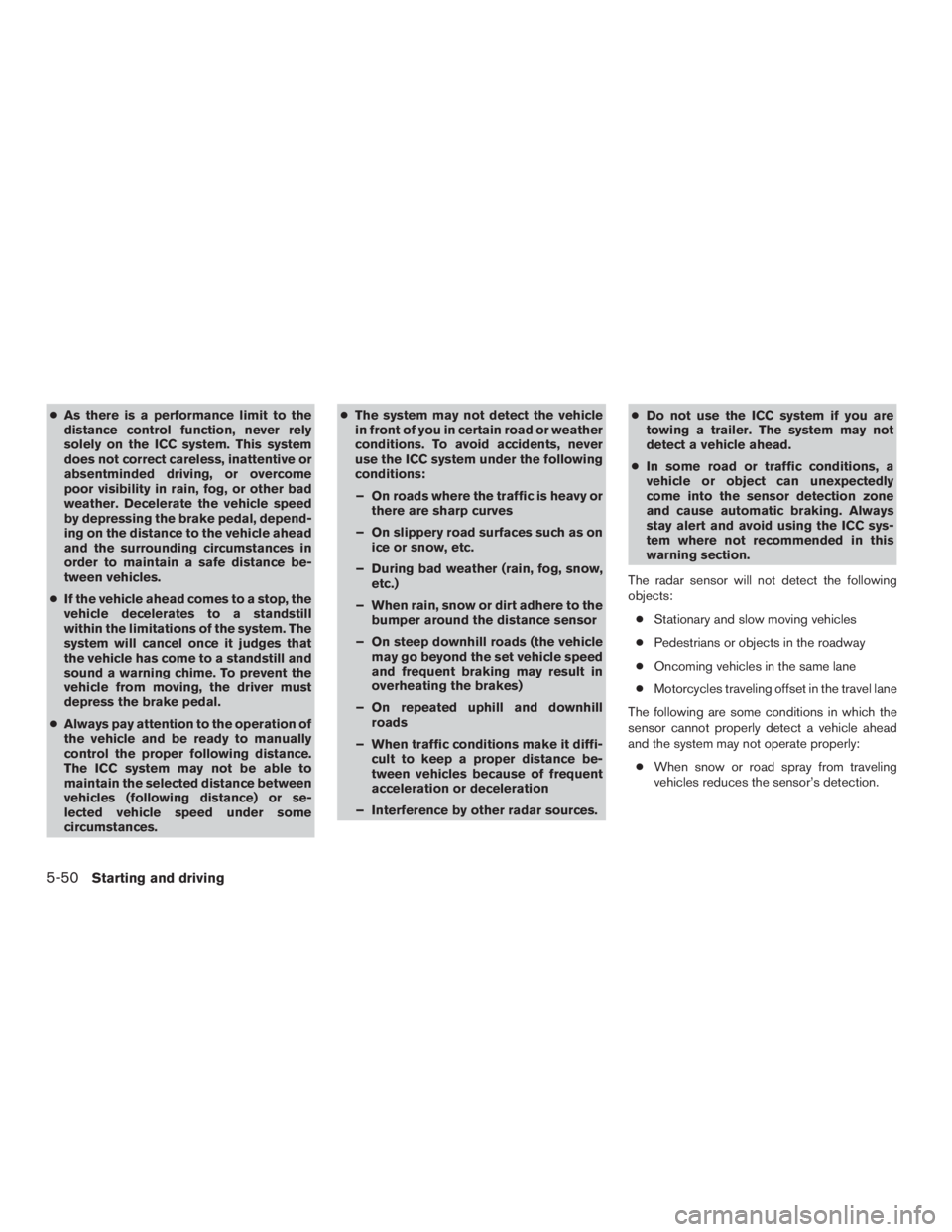
●As there is a performance limit to the
distance control function, never rely
solely on the ICC system. This system
does not correct careless, inattentive or
absentminded driving, or overcome
poor visibility in rain, fog, or other bad
weather. Decelerate the vehicle speed
by depressing the brake pedal, depend-
ing on the distance to the vehicle ahead
and the surrounding circumstances in
order to maintain a safe distance be-
tween vehicles.
● If the vehicle ahead comes to a stop, the
vehicle decelerates to a standstill
within the limitations of the system. The
system will cancel once it judges that
the vehicle has come to a standstill and
sound a warning chime. To prevent the
vehicle from moving, the driver must
depress the brake pedal.
● Always pay attention to the operation of
the vehicle and be ready to manually
control the proper following distance.
The ICC system may not be able to
maintain the selected distance between
vehicles (following distance) or se-
lected vehicle speed under some
circumstances. ●
The system may not detect the vehicle
in front of you in certain road or weather
conditions. To avoid accidents, never
use the ICC system under the following
conditions:
– On roads where the traffic is heavy or there are sharp curves
– On slippery road surfaces such as on ice or snow, etc.
– During bad weather (rain, fog, snow, etc.)
– When rain, snow or dirt adhere to the bumper around the distance sensor
– On steep downhill roads (the vehicle may go beyond the set vehicle speed
and frequent braking may result in
overheating the brakes)
– On repeated uphill and downhill roads
– When traffic conditions make it diffi- cult to keep a proper distance be-
tween vehicles because of frequent
acceleration or deceleration
– Interference by other radar sources. ●
Do not use the ICC system if you are
towing a trailer. The system may not
detect a vehicle ahead.
● In some road or traffic conditions, a
vehicle or object can unexpectedly
come into the sensor detection zone
and cause automatic braking. Always
stay alert and avoid using the ICC sys-
tem where not recommended in this
warning section.
The radar sensor will not detect the following
objects: ● Stationary and slow moving vehicles
● Pedestrians or objects in the roadway
● Oncoming vehicles in the same lane
● Motorcycles traveling offset in the travel lane
The following are some conditions in which the
sensor cannot properly detect a vehicle ahead
and the system may not operate properly: ● When snow or road spray from traveling
vehicles reduces the sensor’s detection.
5-50Starting and driving
Page 332 of 466
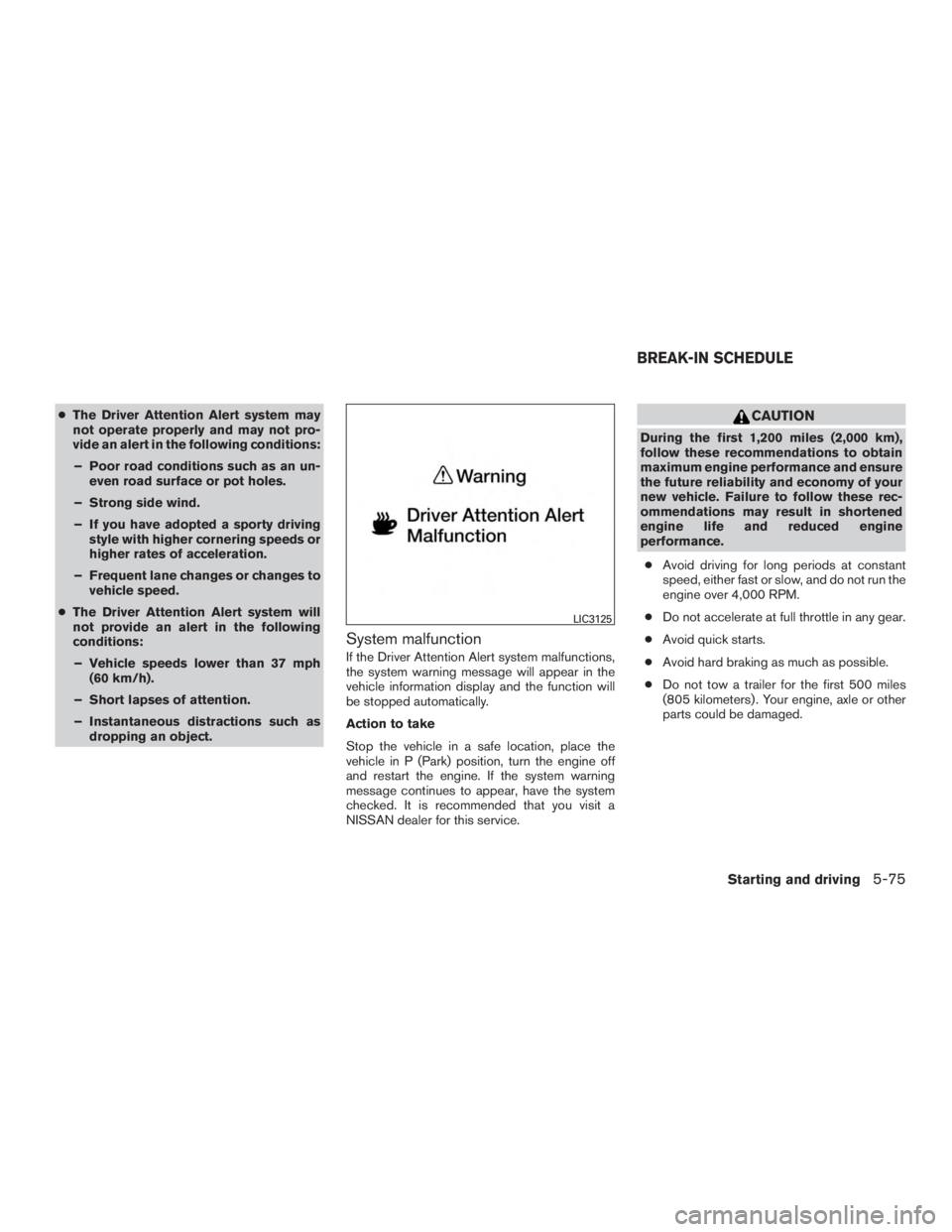
●The Driver Attention Alert system may
not operate properly and may not pro-
vide an alert in the following conditions:
– Poor road conditions such as an un- even road surface or pot holes.
– Strong side wind.
– If you have adopted a sporty driving style with higher cornering speeds or
higher rates of acceleration.
– Frequent lane changes or changes to vehicle speed.
● The Driver Attention Alert system will
not provide an alert in the following
conditions:
– Vehicle speeds lower than 37 mph (60 km/h).
– Short lapses of attention.
– Instantaneous distractions such as dropping an object.
System malfunction
If the Driver Attention Alert system malfunctions,
the system warning message will appear in the
vehicle information display and the function will
be stopped automatically.
Action to take
Stop the vehicle in a safe location, place the
vehicle in P (Park) position, turn the engine off
and restart the engine. If the system warning
message continues to appear, have the system
checked. It is recommended that you visit a
NISSAN dealer for this service.
Page 338 of 466
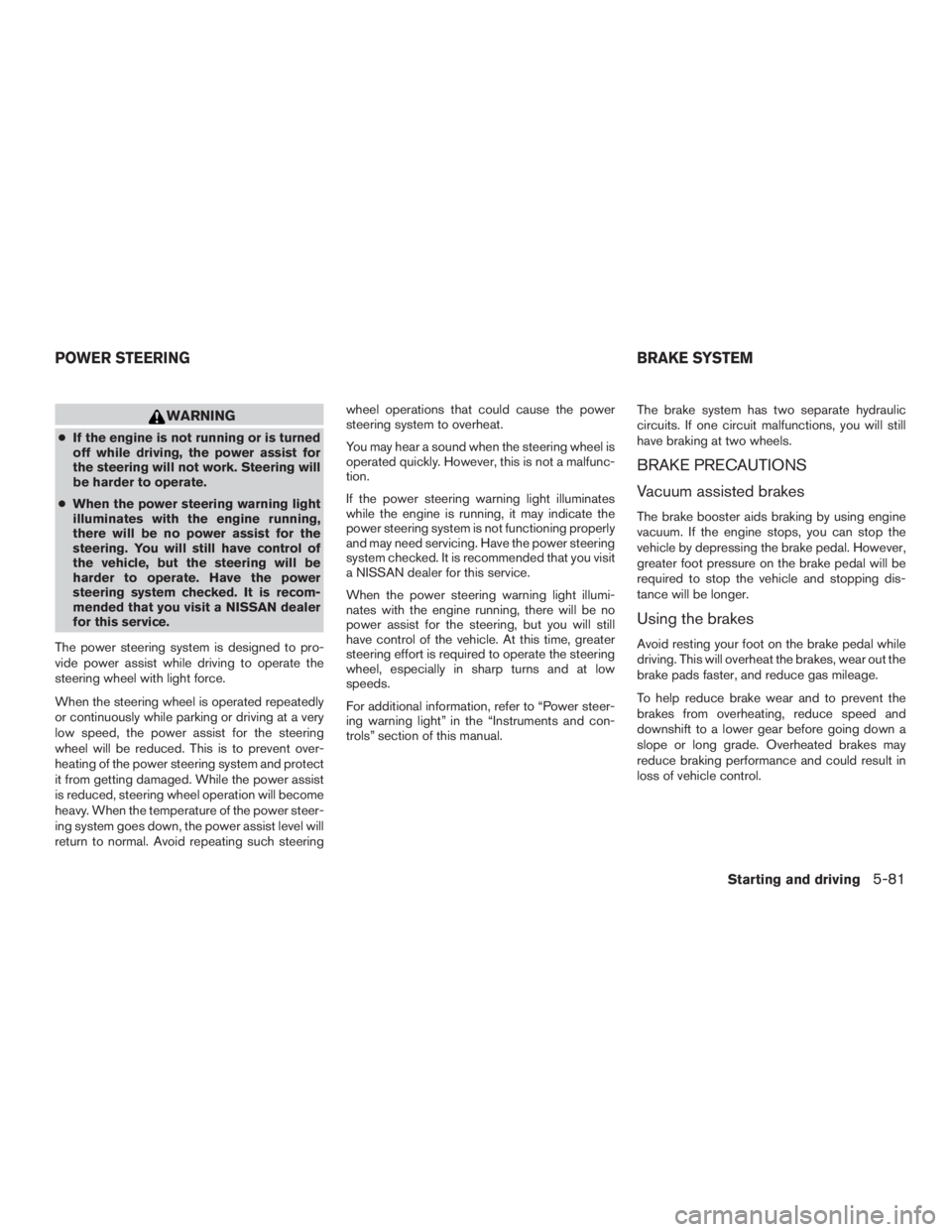
WARNING
●If the engine is not running or is turned
off while driving, the power assist for
the steering will not work. Steering will
be harder to operate.
● When the power steering warning light
illuminates with the engine running,
there will be no power assist for the
steering. You will still have control of
the vehicle, but the steering will be
harder to operate. Have the power
steering system checked. It is recom-
mended that you visit a NISSAN dealer
for this service.
The power steering system is designed to pro-
vide power assist while driving to operate the
steering wheel with light force.
When the steering wheel is operated repeatedly
or continuously while parking or driving at a very
low speed, the power assist for the steering
wheel will be reduced. This is to prevent over-
heating of the power steering system and protect
it from getting damaged. While the power assist
is reduced, steering wheel operation will become
heavy. When the temperature of the power steer-
ing system goes down, the power assist level will
return to normal. Avoid repeating such steering wheel operations that could cause the power
steering system to overheat.
You may hear a sound when the steering wheel is
operated quickly. However, this is not a malfunc-
tion.
If the power steering warning light illuminates
while the engine is running, it may indicate the
power steering system is not functioning properly
and may need servicing. Have the power steering
system checked. It is recommended that you visit
a NISSAN dealer for this service.
When the power steering warning light illumi-
nates with the engine running, there will be no
power assist for the steering, but you will still
have control of the vehicle. At this time, greater
steering effort is required to operate the steering
wheel, especially in sharp turns and at low
speeds.
For additional information, refer to “Power steer-
ing warning light” in the “Instruments and con-
trols” section of this manual.
The brake system has two separate hydraulic
circuits. If one circuit malfunctions, you will still
have braking at two wheels.
BRAKE PRECAUTIONS
Vacuum assisted brakes
The brake booster aids braking by using engine
vacuum. If the engine stops, you can stop the
vehicle by depressing the brake pedal. However,
greater foot pressure on the brake pedal will be
required to stop the vehicle and stopping dis-
tance will be longer.
Using the brakes
Avoid resting your foot on the brake pedal while
driving. This will overheat the brakes, wear out the
brake pads faster, and reduce gas mileage.
To help reduce brake wear and to prevent the
brakes from overheating, reduce speed and
downshift to a lower gear before going down a
slope or long grade. Overheated brakes may
reduce braking performance and could result in
loss of vehicle control.
POWER STEERING
BRAKE SYSTEM
Starting and driving5-81
Page 340 of 466

WARNING
Do not pump the brake pedal. Doing so
may result in increased stopping
distances.
Self-test feature
The ABS includes electronic sensors, electric
pumps, hydraulic solenoids and a computer. The
computer has a built-in diagnostic feature that
tests the system each time you start the engine
and move the vehicle at a low speed in forward or
reverse. When the self-test occurs, you may hear
a “clunk” noise and/or feel a pulsation in the brake
pedal. This is normal and does not indicate a
malfunction. If the computer senses a malfunc-
tion, it switches the ABS off and illuminates the
ABS warning light on the instrument panel. The
brake system then operates normally, but without
anti-lock assistance.
If the ABS warning light illuminates during the
self-test or while driving, have the vehicle
checked. It is recommended that you visit a
NISSAN dealer for this service.
Normal operation
The ABS operates at speeds above3-6mph(5
- 10 km/h). The speed varies according to road
conditions.When the ABS senses that one or more wheels
are close to locking up, the actuator rapidly ap-
plies and releases hydraulic pressure. This action
is similar to pumping the brakes very quickly. You
may feel a pulsation in the brake pedal and hear a
noise from under the hood or feel a vibration from
the actuator when it is operating. This is normal
and indicates that the ABS is operating properly.
However, the pulsation may indicate that road
conditions are hazardous and extra care is re-
quired while driving.
BRAKE ASSIST
When the force applied to the brake pedal ex-
ceeds a certain level, the brake assist is activated
generating greater braking force than a conven-
tional brake booster even with light pedal force.
Page 345 of 466
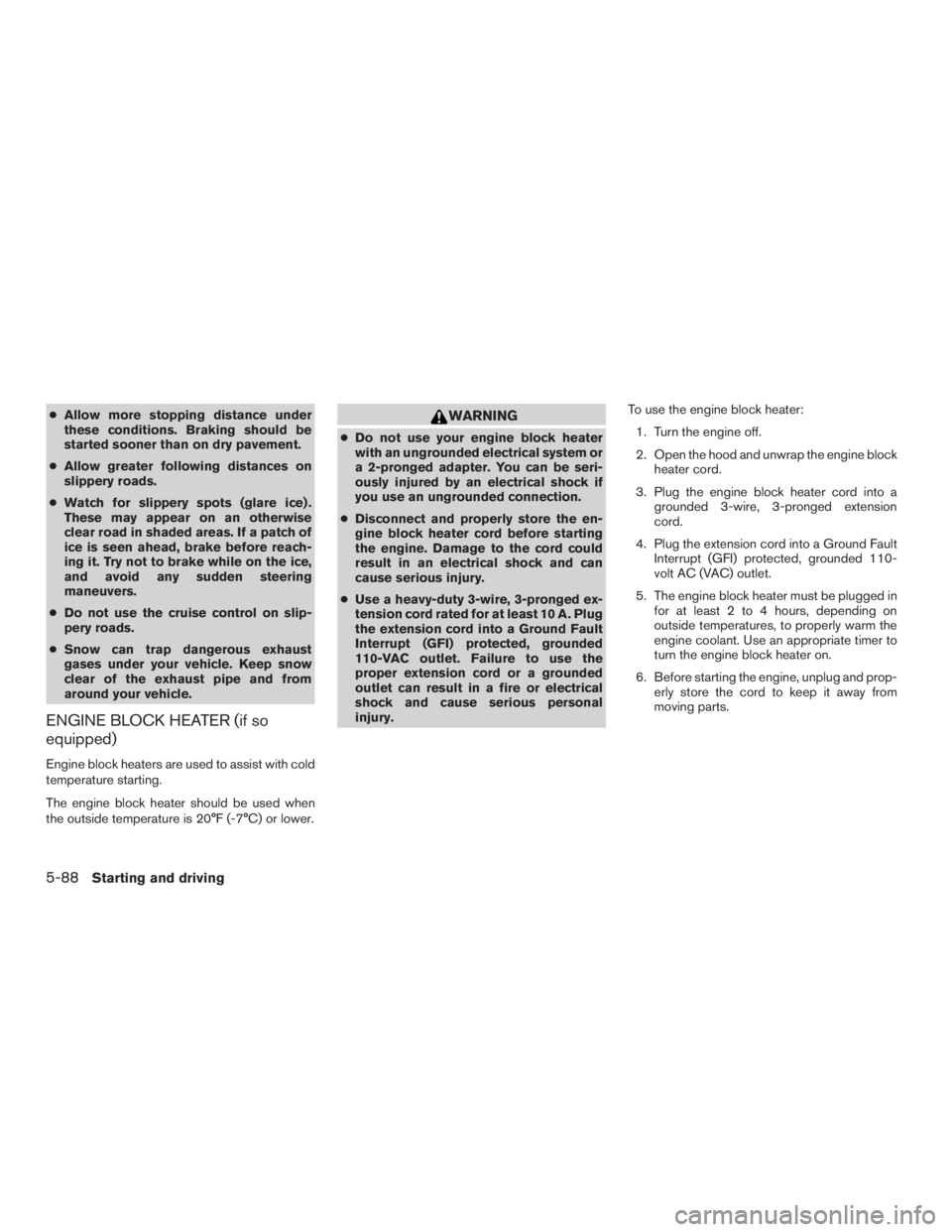
●Allow more stopping distance under
these conditions. Braking should be
started sooner than on dry pavement.
● Allow greater following distances on
slippery roads.
● Watch for slippery spots (glare ice) .
These may appear on an otherwise
clear road in shaded areas. If a patch of
ice is seen ahead, brake before reach-
ing it. Try not to brake while on the ice,
and avoid any sudden steering
maneuvers.
● Do not use the cruise control on slip-
pery roads.
● Snow can trap dangerous exhaust
gases under your vehicle. Keep snow
clear of the exhaust pipe and from
around your vehicle.
ENGINE BLOCK HEATER (if so
equipped)
Engine block heaters are used to assist with cold
temperature starting.
The engine block heater should be used when
the outside temperature is 20°F (-7°C) or lower.
Page 446 of 466
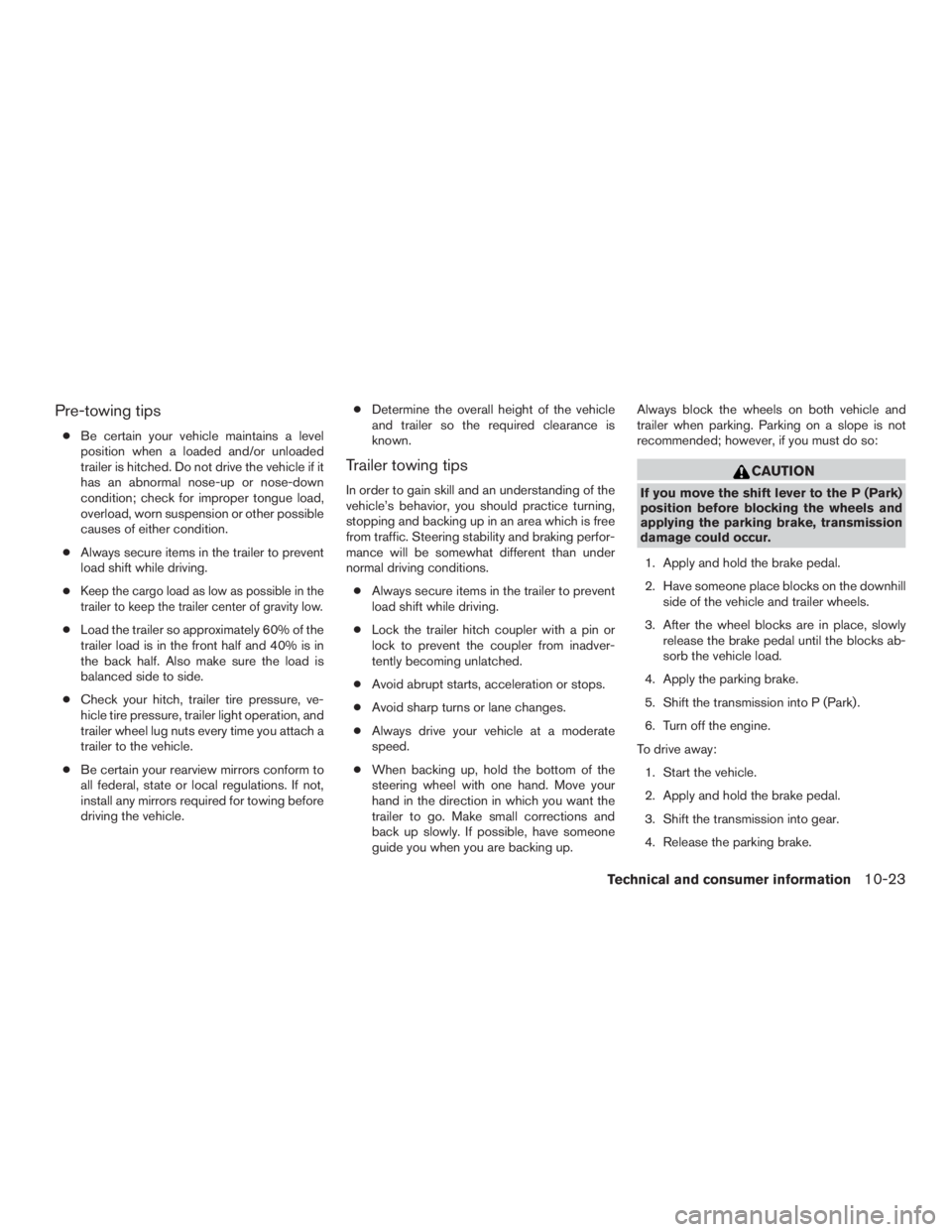
Pre-towing tips
●Be certain your vehicle maintains a level
position when a loaded and/or unloaded
trailer is hitched. Do not drive the vehicle if it
has an abnormal nose-up or nose-down
condition; check for improper tongue load,
overload, worn suspension or other possible
causes of either condition.
● Always secure items in the trailer to prevent
load shift while driving.
●
Keep the cargo load as low as possible in the
trailer to keep the trailer center of gravity low.
● Load the trailer so approximately 60% of the
trailer load is in the front half and 40% is in
the back half. Also make sure the load is
balanced side to side.
● Check your hitch, trailer tire pressure, ve-
hicle tire pressure, trailer light operation, and
trailer wheel lug nuts every time you attach a
trailer to the vehicle.
● Be certain your rearview mirrors conform to
all federal, state or local regulations. If not,
install any mirrors required for towing before
driving the vehicle. ●
Determine the overall height of the vehicle
and trailer so the required clearance is
known.
Trailer towing tips
In order to gain skill and an understanding of the
vehicle’s behavior, you should practice turning,
stopping and backing up in an area which is free
from traffic. Steering stability and braking perfor-
mance will be somewhat different than under
normal driving conditions.
● Always secure items in the trailer to prevent
load shift while driving.
● Lock the trailer hitch coupler with a pin or
lock to prevent the coupler from inadver-
tently becoming unlatched.
● Avoid abrupt starts, acceleration or stops.
● Avoid sharp turns or lane changes.
● Always drive your vehicle at a moderate
speed.
● When backing up, hold the bottom of the
steering wheel with one hand. Move your
hand in the direction in which you want the
trailer to go. Make small corrections and
back up slowly. If possible, have someone
guide you when you are backing up. Always block the wheels on both vehicle and
trailer when parking. Parking on a slope is not
recommended; however, if you must do so:
Page 459 of 466
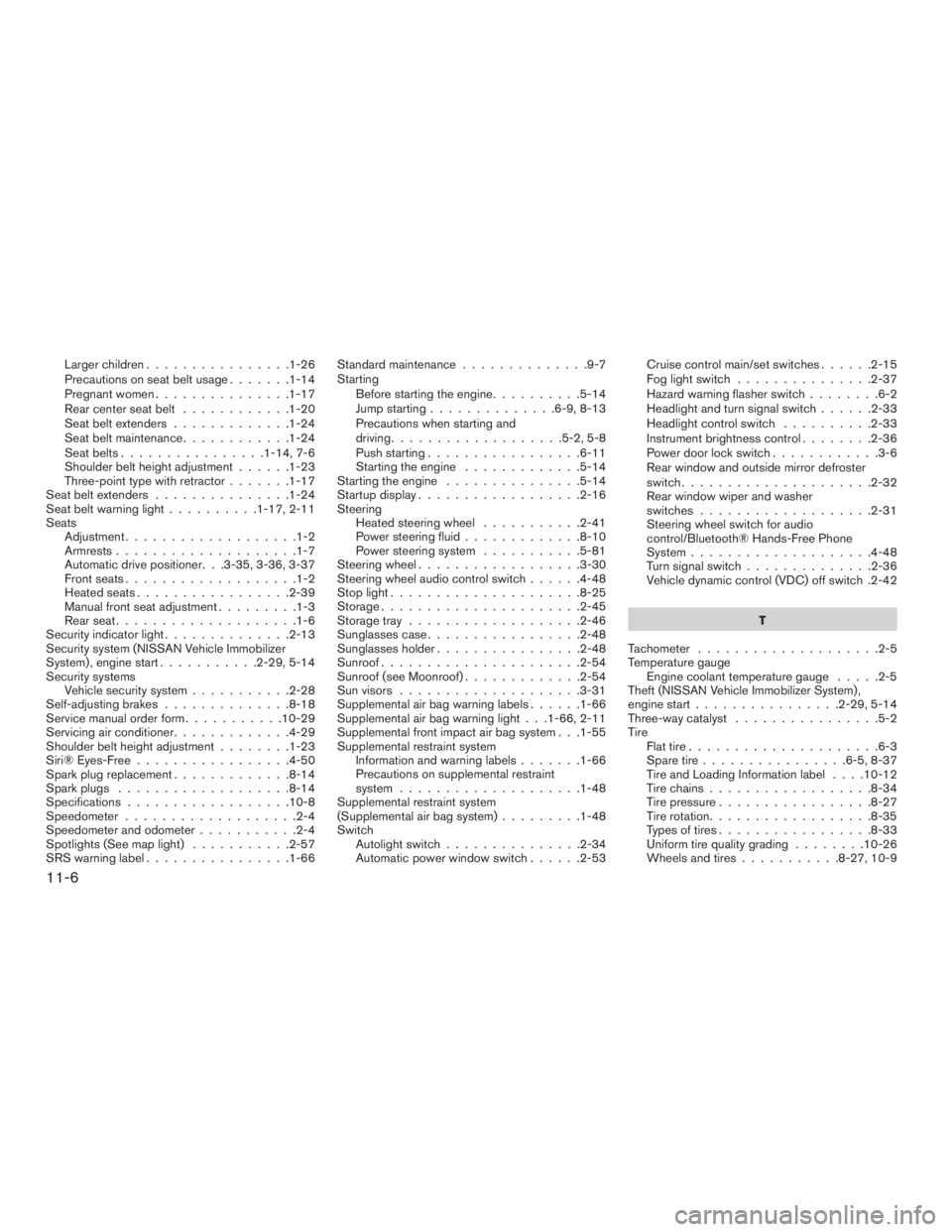
Largerchildren................1-26
Precautionsonseatbeltusage.......1-14
Pregnant women...............1-17
Rear center seat belt ............1-20
Seat belt extenders .............1-24
Seat belt maintenance ............1-24
Seat belts ................1-14,7-6
Shoulder belt height adjustment ......1-23
Three-point type with retractor .......1-17
Seat belt extenders ...............1-24
Seatbeltwarninglight..........1-17,2-11
Seats Adjustment ...................1-2
Armrests....................1-7
Automatic drive positioner. . .3-35, 3-36, 3-37
Frontseats...................1-2
Heatedseats.................2-39
Manual front seat adjustment .........1-3
Rear seat ....................1-6
Security indicator light ..............2-13
Security system (NISSAN Vehicle Immobilizer
System) , engine start ...........2-29,5-14
Security systems Vehicle security system ...........2-28
Self-adjusting brakes ..............8-18
Service manual order form ...........10-29
Servicing air conditioner .............4-29
Shoulder belt height adjustment ........1-23
Siri® Eyes-Free .................4-50
Spark plug replacement .............8-14
Spark plugs ...................8-14
Specifications ..................10-8
Speedometer ...................2-4
Speedometer and odometer ...........2-4
Spotlights(Seemaplight) ...........2-57
SRS warning label ................1-66 Standard maintenance
..............9-7
Starting Before starting the engine ..........5-14
Jump starting ..............6-9,8-13
Precautions when starting and
driving ...................5-2,5-8
Push starting .................6-11
Starting the engine .............5-14
Starting the engine ...............5-14
Startup display ..................2-16
Steering Heated steering wheel ...........2-41
Power steering fluid .............8-10
Power steering system ...........5-81
Steeringwheel..................3-30
Steering wheel audio control switch ......4-48
Stoplight.....................8-25
Storage......................2-45
Storage tray ...................2-46
Sunglassescase.................2-48
Sunglassesholder................2-48
Sunroof......................2-54
Sunroof(seeMoonroof).............2-54
Sun visors ....................3-31
Supplemental air bag warning labels ......1-66
Supplemental air bag warning light . . .1-66, 2-11
Supplemental front impact air bag system . . .1-55
Supplemental restraint system Information and warning labels .......1-66
Precautions on supplemental restraint
system ....................1-48
Supplemental restraint system
(Supplemental air bag system) .........1-48
Switch Autolightswitch...............2-34
Automatic power window switch ......2-53Cruise control main/set switches
......2-15
Fog light switch ...............2-37
Hazard warning flasher switch ........6-2
Headlightandturnsignalswitch......2-33
Headlight
control switch ..........2-33
Instrument brightness control ........2-36
Power door lock switch ............3-6
Rear window and outside mirror defroster
switch .....................2-32
Rear window wiper and washer
switches ...................2-31
Steering wheel switch for audio
control/Bluetooth® Hands-Free Phone
System ....................4-48
Turnsignalswitch..............2-36
Vehicle dynamic control (VDC) off switch .2-42
T
Tachometer ....................2-5
Temperature gauge Engine coolant temperature gauge .....2-5
Theft (NISSAN Vehicle Immobilizer System) ,
engine start ................2-29,5-14
Three-way catalyst ................5-2
Tire Flat tire .....................6-3
Spare tire ................6-5,8-37
Tire and Loading Information label ....10-12
Tire chains ..................8-34
Tire pressure .................8-27
Tire rotation..................8-35
Types of tires .................8-33
Uniform tire quality grading ........10-26
Wheels and tires ...........8-27,10-9
11-6